#Augustinian monks
Explore tagged Tumblr posts
Text
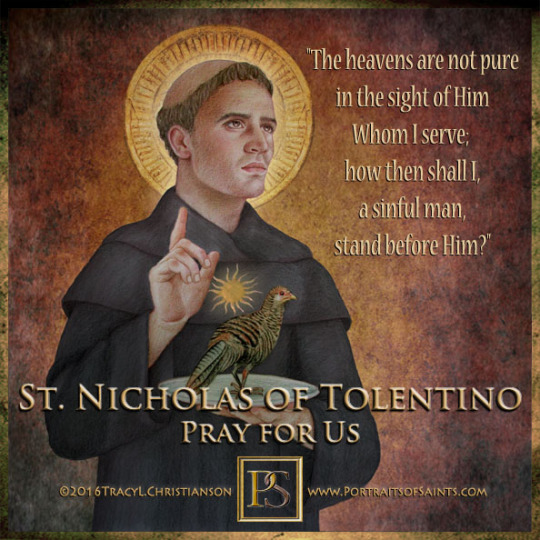
Saint Nicholas of Tolentino 1245-1305 Feast day: September 10 Patronage: Holy Souls in Purgatory, animals, babies, boatmen, dying people, mariners, sailors
Saint Nicholas of Tolentino, the first Augustinian to be canonized, was born in Italy to pious parents. At 18, he became a monk and at 25, an Augustinian priest. St. Nicholas was known for his preaching, administering the sacraments, ministering to the poor and criminal and his great devotion and prayers for the souls in purgatory. His first Mass was said with such fervor that his heart shown with a glow of a fire. A vegetarian, Nicholas was once served roasted fowl, he blessed it and it flew out the window. Nine passengers on a ship going down at sea once asked his aid and he appeared in the sky and quelled the storm with his right hand. He had the reputation as a mystic, wonder-worker, and healer, even raising the dead and was credited with 300 miracles at his canonization.
Prints, plaques & holy cards available for purchase here: (website)
44 notes
·
View notes
Text

On 28th February, 1539, 7 men were burned at the stake in Edinburgh.
Thomas Forret, the Vicar of Dollar, John Keillor and John Beveridge, two black-friars, Duncan Simpson a priest, and a gentleman named Robert Forrester, were all burned together on the Castle Hill on a charge of heresy.
The persecution of Protestants in Scotland, at least if measured in martyrdoms, peaked in 1539, shortly after Cardinal David Beaton, a zealous opponent of reform, was appointed primate of the country, although from the info I have picked up one, John Lauder, would have been the man condemning these men, he was Scotland’s Public Accuser of Heretics at the times. Heretics being anyone who didn’t follow the Catholic faith.
Of the five “heresiarchs” executed in Edinburgh, none had quite so fascinating a tale as Thomas Forret, an Augustinian monk turned Vicar whose passion for Scripture and preaching, coupled with frank observation of the institutional Church’s doctrinal and practical failings, earned him a place at the stake at the crest of the Royal Mile, just east of Edinburgh Castle.
Forret had been warned by the high heid yins about his behaviour on the pulpit a few times, one occasion said his sermons might lead to “make the people thinke” but, a very smart man, he rebuked the accusations of going against the lords work by quoting scriptures and his quick wit. At the time in Scotland the sermons were traditionally performed by “Black Friars” and “Grey Friars” That’s Dominican and Franciscan Monks to you and I!
It would all come undone in 1539 when Forret attended the wedding of the Priest of Tullibody, which attendance, no less than the marriage itself, flouted the Church’s stance position on clerical celibacy. Forret had added insult to injury by eating meat at his fellow curate’s wedding celebration, despite the fact that it was Lent.
So grievous were Forret’s collective crimes that, at his trial, he was condemned to death “without anie place for recantatioun.”
Subsequently brought to the place of his execution, a certain Friar Hardbuckell encouraged him to save his soul by confessing his faith in God. “I beleeve in God,” Forret replied. Hardbuckell then encouraged him to confess his faith in the Virgin Mary by adding the words “and in our Ladie.” Forret answered, “I beleeve as our Ladie beleeveth,” thereby maintaining to the end the perfect and full sufficiency of Christ’s saving work for sinners.
Forret’s wit and knowledge of Scripture stayed with him to his very last breath. Having been preceded to his execution by one of his fellow martyrs, Forret called the same a “wily fellow” who wished to arrive at the feast awaiting them in heaven before the others in order to secure a good seat. As tied to the stake, he began to recite Psalm 51 in Latin: Misere mei, Deus, secundum magnam misericordiam tuam. “Have mercy on me, O God, according to your steadfast love.” Thus he continued “till they pulled the stoole frome under his feete, and so wirried [hanged], and after burnt him.”
12 notes
·
View notes
Photo

Anton Bruckner
Anton Bruckner (1824-1896) was an Austrian composer, most famous for his nine grand symphonies and his church music. Never quite gaining full recognition for his work until he was in his sixties, Bruckner's music, with its strong spiritual emphasis, continues to divide the music community, creating admirers and detractors in equal measure.
Early Life
Anton Bruckner was born in Ansfelden, Upper Austria, on 4 September 1824. His father was a schoolmaster, devout Catholic, and the village organist. Anton had five younger siblings, and he learnt music from his father at an early age. Aged 13 and following his father's death, Anton joined the choir at the nearby Abbey Church of the monastery of Saint Florian, run by Augustinian monks. He followed in his father's steps when he gained employment as a village schoolmaster in 1840. Over the next five years, he moved around various towns and villages, always teaching. Anton again repeated his father's career steps when he, too, became an organist, this time at the Saint Florian Abbey. He had returned to Ansfelden in 1845 where he continued to work as a teacher, but once he gained a formal teaching qualification, he was able to gain a better salary and a position at St. Florian's. His organ skills soon shone through in church services. Anton was keen to compose, and early works include the Missa solemnis in B flat, but he was ambitious for more than local fame.
In 1855, Bruckner moved to Linz, where, from the next year, he worked as the first organist in the great cathedral, a position that included free accommodation. Bruckner held the organist position for 12 years, and the instrument would influence his composing style. Eager to improve his composing skills, he followed a correspondence course supplied by the Vienna Conservatory, which focussed on harmony and counterpoint. This was an unconventional route for someone who became a master of his art, certainly, it was a time-consuming one. Bruckner graduated in 1861 with great honours, one teacher ruefully remarked, "If I knew one tenth of what he knows, I'd be happy" (Sadie, 274). Bruckner was not quite finished with his studies, though. The 37-year-old next learnt more about orchestration and symphonic form under Simon Sechter (1788-1867), a respected teacher at the Vienna Conservatory. Bruckner travelled to Vienna once a week to have his lesson. Another teacher was Otto Kitzler, conductor at the Linz Theatre.
Bruckner was influenced by the work of Ludwig van Beethoven (1770-1827) and Johannes Brahms (1833-1897). Even more influential than these composers was the work of Richard Wagner (1813-1883), in particular his epic opera Tannhäusser, which Bruckner first heard in 1863, and then, personally invited to attend by the composer, Wagner's Tristan in Munich in 1864. Turning 40, Bruckner was finally inspired to make his mark in the wider world of classical music. He composed three masses, including Mass in D minor (completed in 1864), before turning to what would be his preferred format, the symphony.
Continue reading...
13 notes
·
View notes
Text
my problem is that I have the spirit of a medieval monk. I am meant to be in the cloisters. tonsured. looking after my lil garden. having sodomy with brother roger who's norman and kind of a freak. you know how it is with augustinians
9 notes
·
View notes
Text
[Events in the early thirteenth century disrupted Ida and Renaud's partnership.] Between spring 1210 and autumn 1211, the relationship between Renaud and the king [Philip Augustus] unraveled in the face of King John’s efforts to regain the allegiance of the northern French lords and the revived fortunes of Otto of Brunswick, once again king of Germany (and nephew of John and Ida). Philip’s suspicions, aroused by the presence of Eustace the monk in Boulogne (formerly seneschal of Boulogne and now John’s spy), led him to renegotiate the terms of the marriage agreement between Matilda of Boulogne and his son Philippe in 1209 and again in 1210. The documents only refer to Renaud, but it seems likely that Ida was part of the discussions.
Shortly after the second revision, the ten-year-old pair were wed in May 1210. This triggered the stipulation that Matilda’s dowry (all the family’s Norman lands, excluding Mortain, Lillebonne, and Alisay) were to be turned over to royal control on October 1, 1211. Renaud began refortifying Mortain Castle, in part a response to his support of his cousin Catherine, countess of Clermont’s, conflict with Philip, bishop of Beauvais (a royal cousin). Philip accused Renaud of disloyalty and demanded that the castle be surrendered by September 8, 1211, as security for his fidelity or be judged in default.
What advice Ida gave Renaud in the autumn of 1211 before the break with Philip II is unknown. None of the chronicles relate Ida’s role in the swift dissolution of the ties between the king and her husband. All Renaud’s efforts to negotiate matters with Philip were rebuffed. She, Renaud, and her brother-in-law, Simon, fled to safety, first to the county of Bar and then to England. Renaud swore allegiance to John, and Ida served as a hostage for Renaud’s good faith. Philip reacted swiftly by confiscating their lands and appointing his son Louis the ruler of Boulogne. Renaud, with the aid of William Longsword and Hugh de Boves, served as John’s emissaries and commanders in the region between 1212 and 1214. They were joined by Ferrand, count of Flanders, and Louis and Philip were hard pressed in the region.
At the battle of Bouvines (July 27, 1214), Renaud fought valiantly until the end, but he and Ferrand were captured. Ferrand was imprisoned at the Louvre for his defiance, but Countess Jeanne was allowed to rule Flanders, albeit under tight royal supervision, until he was released in 1231. Renaud was chained up at Péronne Castle and never released.
Afterwards, Ida sought to ransom Renaud from Philip II, both directly and with the aid of Countess Jeanne of Flanders, but her efforts failed. She retired to the Augustinian house of Zonnebeke, where she died in 1216. Renaud died in captivity in 1227. Between 1212 and 1223, Prince Louis governed Boulogne, and, to a lesser degree, Artois. Boulogne served as his supply base during his English campaigns from the winter of 1216 until the fall of 1217; consequentially, the Honour of Boulogne escheated to the crown.
— Heather J. Tanner, Lordship and Governance by the Inheriting Countesses of Boulogne, 1160-1260
#the way their marriage began with them against the world and ended with them getting forced apart 💔#Their daughter Matilda eventually regained her parents' stolen inheritance and ruled Boulogne till her death as its last Countess#ida of boulogne#renaud of dammartin#french history#Philip Augustus#13th century#my post#women in history
5 notes
·
View notes
Photo
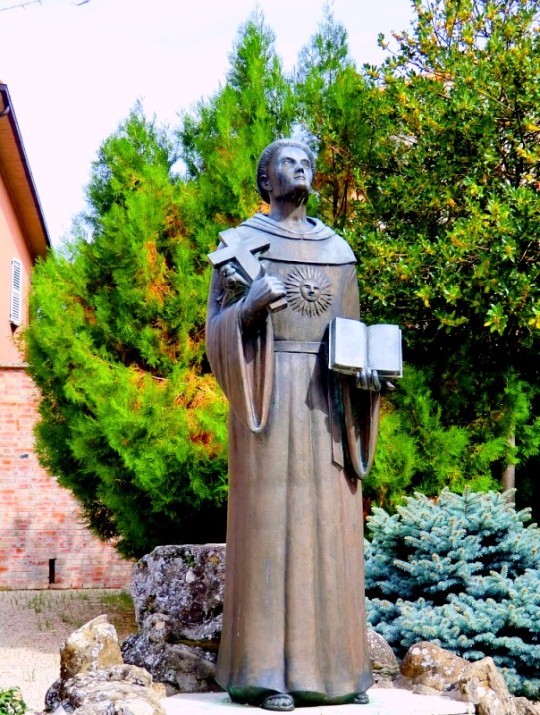
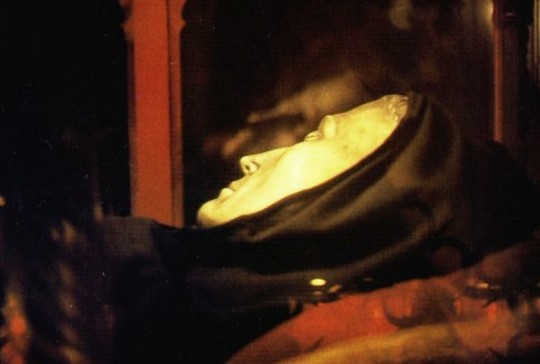
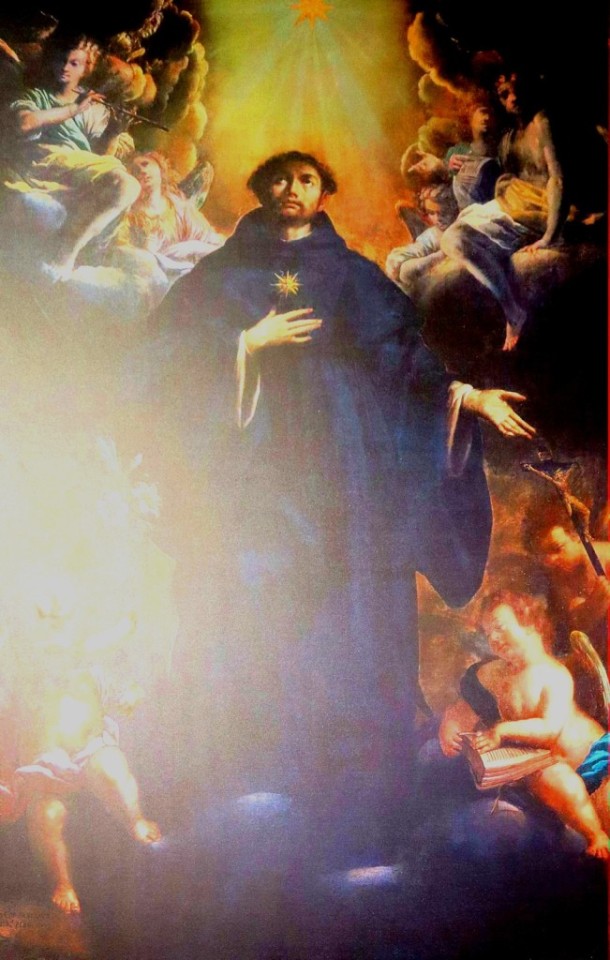
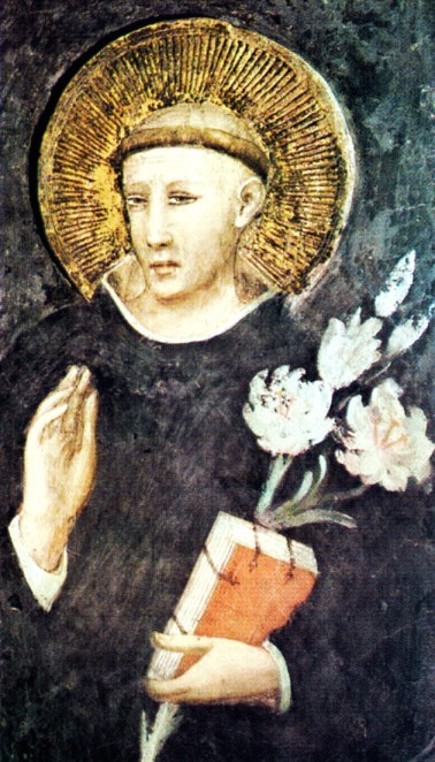

Saint of the Day – 10 September – Saint Nicholas of Tolentino OSA (1245-1305) Confessor, “The Patron of Holy Souls” Priest, Augustinian Friar Monk, Mystic, Preacher, Miralce-worker and Apostle of the poor, the sick, the needy. Patronages – animals, babies (reported to have raised more than 100 children from the dead), sailors, dying people, sick animals, the Holy Souls in Purgatory, 4 Cities, 3 Diocese. The Name Nicholas from the Greek means means: “the victor over the people.” The Roman Martyrology reads today: “At Tolentino, in the March of Ancona, the departure from this life of St Nicholas, Confessor of the Order of Augustinians.”
(via Saint of the Day – 10 September – Saint Nicholas of Tolentino OSA (1245-1305) Confessor, – AnaStpaul)
17 notes
·
View notes
Text
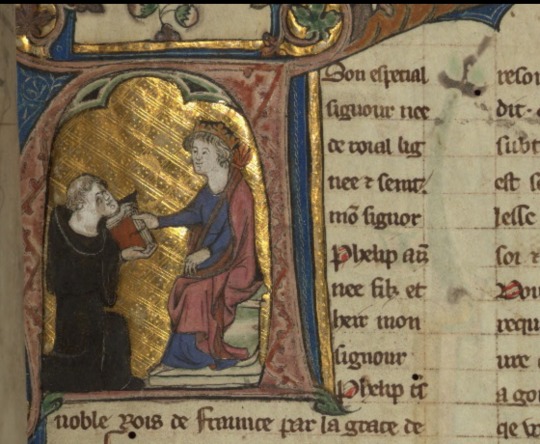
Walters Art Museum Les livres du gouvernement des roys et des princes W.144 f.2r
A kneeling Giles of Rome, dressed in the black habit of an Augustinian monk, presenting the book to a seated Philip the Fair
#medieval#medieval manuscripts#middle ages#illuminated manuscript#cloistercore#medieval core#medieval monk#calligraphy#medieval monks#monkposting
53 notes
·
View notes
Text
amusing bits from Martin Luther: Renegade and Prophet so far:
* "What sparked [Luther's] anger, so he later reminisced, was the preaching of a Dominican friar, Johannes Tetzel, in the nearby town of Jüterborg, who went so far as to claim that his indulgences were so efficacious that even if a person had raped the Virgin Mary they would be assured complete remission from Purgatory." used car salesman-ass strategy lol
* "...the wealth of material that has survived on Luther is so great that we probably know more about his inner life than about that of any other sixteenth-century individual... His collected works, the famous Weimar Edition, extend to 120 volumes, including 11 volumes of letters and 6 volumes of his dinner-table conversations"
holy FUCK. truly a poaster before his time. like would the median tumblr blog fill 120 volumes jeez
* "In the early years of the Reformation, for example, [Luther] talked constantly of invidia, or envy, attributing it to his opponents—though it is hardly likely that they would have envied a penniless, powerless monk, while he, on the other hand, had every reason to be preoccupied with those he envied." lmao. mean girl who goes "they're just jealous" every time ppl hate on him
* "Extraordinarily, in an age when letters were routinely passed from person to person, were forged or intercepted, and when every chancellery filed drafts, Luther kept no copies. This gave his correspondents huge power, because they alone had records of what he had written, but Luther was relaxed about this, joking that he could always deny his own 'hand,' a remark that reveals his remarkable confidence."
i will have to look into this later but this is lowkey fascinating??? it hadn't occurred to me the 16th century world would've, like. written out copies of every damn thing. to support audit trails and such. just because the overhead of producing all those damn copies seems really high. suggests fun possibilities for intrigue and mailfraud shenanigans lol
* "It was popularly believed that when of the counts [in the town where Luther grew up] commissioned an altarpiece for the chapel depicting the Crucifixion, he had the thief on Christ's right painted as his most hated co-ruler
LMAOOOooo. also reminds me of the funny story that the tobacco magnate who funded the creation of Duke University Chapel asked that the stained glass depict the 12 desciples smoking cigarettes, and the dude had to be talked out of it... though i can't find any reference to the story on the internet, sadly. did the duke chapel tour guide MAKE UP LIES to me
* Luther grew up in a family that owned a mine & it's sort of hilarious how bad all these 1500s miners were at economics. they're like. running whole mining operations but with only the haziest idea of, like. where capital comes from. how to not resource trap your way into fuckedness. etc. i dunk on economists a lot but y'know there are some concepts here that actually were p worth formalizing
* our dude Luther was a fucking DRAMA QUEEN let me tell you:
"[Luther] joined the Augustinian order in Erfurt on July 17, 1505 [...] Luther sent his academic gown and ring home to Mansfeld, telling his parents he had drawn a line under this part of his life. He sold some of the fine legal textbooks his father had bought him and donated others to the monastery. Then he invited all his student comrades to a lavish meal, with music and entertainment. At the height of the party, he told his shocked companions of his decision to become a monk, announcing melodramatically, 'Today you see me and never again!' He then left for the monastery, accompanied by his sobbing companions." bet those dudes never forgot that party
* though Martin Luther's dad sure could match him for drama queen-ness (and apparently never stopped resenting Luther becoming a monk instead of a lawyer):
"At the ensuing feast to celebrate [Luther's first mass a priest], for which Luther's father, always the man for the grand gesture, had given the sum of twenty guilders, the breach was still evident. Luther asked whether his father now accepted his decision, and in front of everyone at the table, Hans Luder replied, 'Remember the fourth commandment, to obey father and mother.' 'What if it was an evil spirit' behind [the storm that convinced Martin to become a monk]? he asked. It was a very serious charge, made at a point where Luther had just acted as Christ's representative on earth for the first time."
* Luther was in one of the more hardcore monkish orders, and said order had a pretty rigorous schedule of prayers that involved waking up in the middle of the night... but apparently you could just pay other monks to pray for you if you just Didn't Feel Like Doing It one day? lmao. and in particular Luther did the strategy of "i'll just get them done ALL IN ONE DAY" instead of, like, doing them throughout the week (going without food or sleep, working that day & night to get them done)
* our dude could definitely be a poor lil meow meow / woobie if fandom got their hands on him. this boy is constantly having literal panic attacks about WHAT IF I MISINTERPRETED THIS PART OF SCRIPTURE AND NOW WE'RE ALL GOING TO HELL, when he's in Rome one of the things that bothers him the most (besides the famous indulgence thing) is the fact that they SPEEDRAN masses over there and he's like "oh no though, i spend SO MUCH time on the masses i run, i'm so afraid of doing it without true feeling... who are these speedrunning fucks with no respect goddamn," his confessor gets tired of him because he'll spend UP TO SIX HOURS AT CONFESSION agonizing over shit that doesn't matter... (this is part of the reason he went into academia, actually, his confessor was like "boy you have got way too much anxiety for the purely monastic life, go get a degree or something i stg")
* i do kinda love it when theologians get sexy with it:
"[Staupitz] wrote of different 'stages' of union of the soul, the first being that of 'young maids in faith,' the second that of the 'concubine,' the third, the 'queens': 'They are naked and copulate with the naked one. They taste that outside Christ there is nothing sweet and they enjoy [his] continuous sweetness. For the naked Christ cannot deny himself to those naked,' while in the fourth stage, which Mary alone experienced, Jesus 'sleeps naked with her naked and he shows other signs of such love.'"
12 notes
·
View notes
Text

4. The Sangha: A Commune Separate From Political Authority
The Buddhist Sangha is often compared to the Benedictine and Augustinian orders of European Christian monks. And this parallel has some uses. But the deference and reverence of the Christian monk vis-à-vis the Buddhist monk is quite different. The Buddhist monk or nun is a renunciant, not to get closer to God and receive rewards in heaven, but to achieve enlightenment, or in the very least, renounce the world as it is polluted with undue suffering. The Sangha was essentially a movement that would attract thousands of followers within Shakyamuni Buddha’s lifetime, and it was founded by people who lived off of the charity (dāna) of their surrounding communities.
Any veneration for monks or nuns received from people in those communities was out of sincere respect alone, and clearly not from a tradition of obedience. There was a sense of shared dignity that emanated from the Sangha, as it was attested in the suttas. And though many monks were indeed venerated, they were not so until they proved themselves to be sagacious in deed and speech. Authority in early Buddhist society had no linkage to possessions, status, or wealth. Their critique of property ownership is even compatible with the works of Proudhon, Kropotkin, and Rocker. The Dhammapada, possibly chief among all Pali Canon texts, states in the subsection Dhammattha Vagga: (discourse on the just), that one is not deserving of respect merely because of their perceived status from birth, age, or charisma, but rather the sum of all their deeds:
260. A monk is not an elder because his head is gray. He is but ripe in age, and he is called one grown old in vain. 261. One in whom there is truthfulness, virtue, inoffensiveness, restraint and self-mastery, who is free from defilements and is wise — he is truly called an Elder. 262. Not by mere eloquence nor by beauty of form does a man become accomplished, if he is jealous, selfish and deceitful. 263. But he in whom these are wholly destroyed, uprooted and extinct, and who has cast out hatred — that wise man is truly accomplished.
Shakyamuni Buddha also warned against false confidence in obedience to rules, rituals, and pedantry. These habits so often manifest as means of authoritarianism, and this principle would ideally promise that Sangha would remain an egalitarian commune that guaranteed equal opportunity to its residents. And if an anarchist commune would be modeled with a similar ethic to these principles, it could safeguard against the rise would-be despots:
271–272. Not by rules and observances, not even by much learning, nor by gain of absorption, nor by a life of seclusion, nor by thinking, “I enjoy the bliss of renunciation, which is not experienced by the worldling” should you, O monks, rest content, until the utter destruction of cankers (Arahantship) is reached.
In the Dhammapada’s Bhikkhu Vagga (discourse on monks), Shakyamuni Buddha gives an emancipatory instruction, 376. “Let him associate with friends who are noble, energetic, and pure in life, let him be cordial and refined in conduct. Thus, full of joy, he will make an end of suffering.” This passage provides an impetus for would-be members of the Sangha to retreat from oppression. Similarly the Buddha warned against oppression by means of violence in the Danda Vagga (discourse on violence). 131. “One who, while himself seeking happiness, oppresses with violence other beings who also desire happiness, will not attain happiness hereafter.” And it has been the anarchist critique that oppressive violence has always been the basis for anarchist thought, or as Proudhon described it, “oppression, misery, and crime”.
Like many anarchist communes today, the Sangha is meant to survive on charity (dāna) and barter alone. This communal subsistence is often called “the economy of gifts” and would ideally allow monastics to sever ties from whatever political regime that existed around them at the time. These days a Sangha exists within a nation-state regardless of their means of subsistence, and this typically renders the upkeep of a Sangha nearly impossible where the tradition is not the norm. And this is just another sign of oppression and systemic violence. But this doesn’t change the fact that wherever a Sangha exists, there is a potential for people within a political realm to seek refuge in the Buddhist community and attain a new life, and oftentimes a new name upon ordination. Many ordained monks went on to be given the title of arahant (an enlightened monk) and they continued Shakamuni’s teachings, assembling in the First Council in Rajagada (5th c. BCE) and Second Council in Vesali (4th c. BCE) whereby much of the Buddhist tradition was chronicled and passed down verbally until written tradition took over during the reign of King Vaṭṭagāmiṇi in the 1st century BCE, and this was when the Pali Canon was formed.
Since much of the early Canon survived while containing suttas that encouraged critical thought, it is only logical to conclude that the Sangha upheld emancipatory doctrine at least until Vaṭṭagāmiṇi’s reign.
So far we have seen Buddhist thought challenge filial piety through the tale of young Siddhartha Gautama’s escape from this oligarchic father’s rule, notions of hierarchy existing as the caste system, and political life by way of the Sangha. Finally this essay will conclude with a discussion about how the Buddha was viewed vis-à-vis the Hindu pantheon, and the parables that narrate discourses he has with the gods of Hinduism.
#desi#desiblr#Buddhism#Caste#India#nonviolence#pacifism#community building#practical anarchism#anarchist society#practical#mutual aid#grassroots#organization#anarchism#resistance#autonomy#revolution#anarchy#daily posts#communism#anti capitalist#anti capitalism#late stage capitalism#grass roots#anarchists#libraries#leftism#social issues#economics
4 notes
·
View notes
Text
If you've spent any amount of time studying Medieval Europe, one thing that you are bound to notice is how many different types of monks there are. Just considering monks proper, you've got Benedictines and Cistercians, and that's not even getting into all of the pseudo-monk-like religious orders. For friars, there are Dominicans, Fransiscians, Augustinians and Carmelites. When you get into canons, there are Agustinian and Norbertines. And all of the above have multiple offshoots and schisms. I'm reminded of the old jokes about the "crab cycle". Just another of the Church's attempts at evolving a monk. There is one step and it is monk.
The only way to make sense of all this is by recognizing the underlying paradox that lies at the heart of medieval monasticism: that monks were fundamentally rich people LARPing at being poor. Monks, nuns, friars, canons and what-have-you all predominantly came from the landed aristocracy, and monestaries themselves were some of the largest landowners in medieval Europe. And at the end of the day, no amount of rules or reforms about what is and isn't acceptable in for your peasantsona is ever going to change that. But the Church remained at least nominally committed to preaching holiness through poverty. And so every hundred years or so, a new order would be founded in a vain attempt to finally square that circle.
6 notes
·
View notes
Text
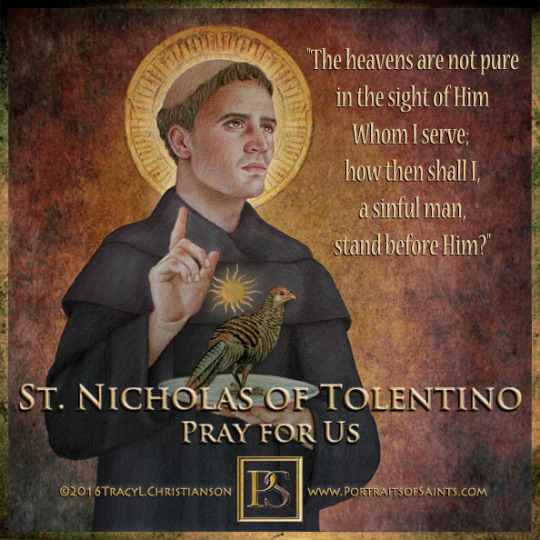
Saint Nicholas of Tolentino 1245-1305 Feast day: September 10 Patronage: Holy Souls in Purgatory, animals, babies, boatmen, dying people, mariners, sailors
Saint Nicholas of Tolentino, the first Augustinian to be canonized, was born in Italy to pious parents. At 18, he became a monk and at 25, an Augustinian priest. St. Nicholas was known for his preaching, administering the sacraments, ministering to the poor and criminal and his great devotion and prayers for the souls in purgatory. His first Mass was said with such fervor that his heart shown with a glow of a fire. A vegetarian, Nicholas was once served roasted fowl, he blessed it and it flew out the window. Nine passengers on a ship going down at sea once asked his aid and he appeared in the sky and quelled the storm with his right hand. He had the reputation as a mystic, wonder-worker, and healer, even raising the dead and was credited with 300 miracles as his canonization.
Prints, plaques & holy cards available for purchase here: (website)
71 notes
·
View notes
Text
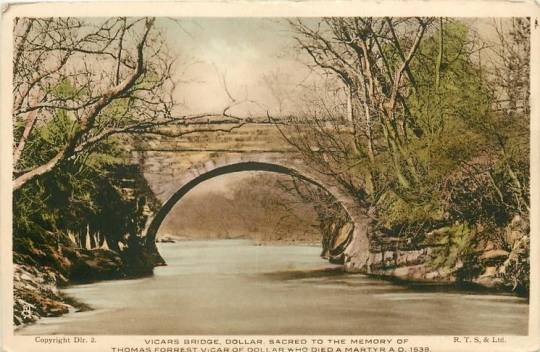
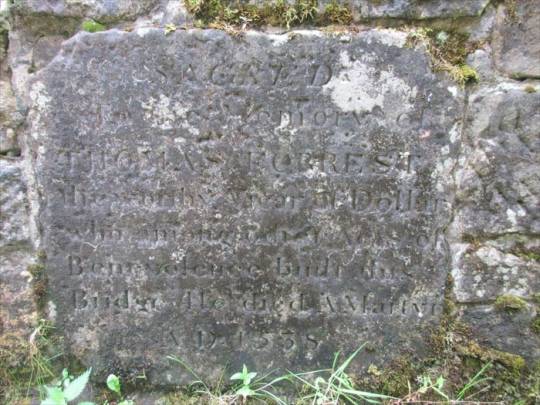
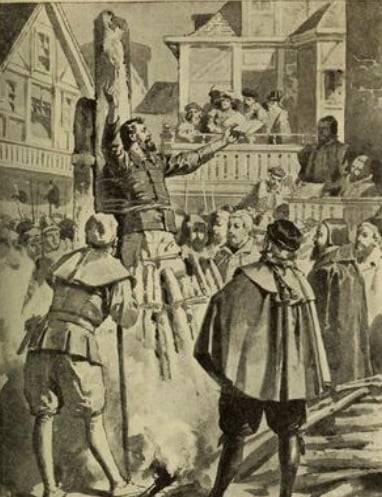
On 28th February, 1539, Thomas Forret, the Vicar of Dollar, John Keillor and John Beveridge, two black-friars, Duncan Simpson a priest, and a gentleman named Robert Forrester, were all burned together on the Castle Hill on a charge of heresy.
The persecution of Protestants in Scotland, at least if measured in martyrdoms, peaked in 1539, shortly after Cardinal David Beaton, a zealous opponent of reform, was appointed primate of the country, although from the info I have picked up one John Lauder, would have been the man condemning these men, he was Scotland’s Public Accuser of Heretics at the times. Heretics being anyone who didn’t follow the Catholic faith.
Of the five “heresiarchs” executed in Edinburgh, none had quite so fascinating a tale as Thomas Forret, an Augustinian monk turned Vicar whose passion for Scripture and preaching, coupled with frank observation of the institutional Church’s doctrinal and practical failings, earned him a place at the stake at the crest of the Royal Mile, just east of Edinburgh Castle.
Forret had been warned by the high heid yins about his behaviour on the pulpit a few times, one occasion said his sermons might lead to “make the people thinke” but, a very smart man, he rebuked the accusations of going against the lords work by quoting scriptures and his quick wit. At the time in Scotland the sermons were traditionally performed by “Black Friars” and “Grey Friars” That’s Dominican and Franciscan Monks to you and I!
It would all come undone in 1539 when Forret attended the wedding of the Priest of Tullibody, which attendance, no less than the marriage itself, flouted the Church’s stance position on clerical celibacy. Forret had added insult to injury by eating meat at his fellow curate’s wedding celebration, despite the fact that it was Lent.
So grievous were Forret’s collective crimes that, at his trial, he was condemned to death “without anie place for recantatioun.”
Subsequently brought to the place of his execution, a certain Friar Hardbuckell encouraged him to save his soul by confessing his faith in God. “I beleeve in God,” Forret replied. Hardbuckell then encouraged him to confess his faith in the Virgin Mary by adding the words “and in our Ladie.” Forret answered, “I beleeve as our Ladie beleeveth,” thereby maintaining to the end the perfect and full sufficiency of Christ’s saving work for sinners.
Forret’s wit and knowledge of Scripture stayed with him to his very last breath. Having been preceded to the gallows by one of his fellow martyrs, Forret called the same a “wily fellow” who wished to arrive at the feast awaiting them in heaven before the others in order to secure a good seat. As the noose was placed around his neck, he began to recite Psalm 51 in Latin: Misere mei, Deus, secundum magnam misericordiam tuam. “Have mercy on me, O God, according to your steadfast love.” Thus he continued “till they pulled the stoole frome under his feete, and so wirried [hanged], and after burnt him.”
Pics are of a memorail stone and bridge over the River Devon between the village of Blairingone and Dollar on the border of Clackmannanshire and Kinross-shire
Much more on the unfortunate man here https://www.reformation21.org/.../scotlands-protestant...
15 notes
·
View notes
Photo

Anton Bruckner
Anton Bruckner (1824-1896) was an Austrian composer, most famous for his nine grand symphonies and his church music. Never quite gaining full recognition for his work until he was in his sixties, Bruckner's music, with its strong spiritual emphasis, continues to divide the music community, creating admirers and detractors in equal measure.
Early Life
Anton Bruckner was born in Ansfelden, Upper Austria, on 4 September 1824. His father was a schoolmaster, devout Catholic, and the village organist. Anton had five younger siblings, and he learnt music from his father at an early age. Aged 13 and following his father's death, Anton joined the choir at the nearby Abbey Church of the monastery of Saint Florian, run by Augustinian monks. He followed in his father's steps when he gained employment as a village schoolmaster in 1840. Over the next five years, he moved around various towns and villages, always teaching. Anton again repeated his father's career steps when he, too, became an organist, this time at the Saint Florian Abbey. He had returned to Ansfelden in 1845 where he continued to work as a teacher, but once he gained a formal teaching qualification, he was able to gain a better salary and a position at St. Florian's. His organ skills soon shone through in church services. Anton was keen to compose, and early works include the Missa solemnis in B flat, but he was ambitious for more than local fame.
In 1855, Bruckner moved to Linz, where, from the next year, he worked as the first organist in the great cathedral, a position that included free accommodation. Bruckner held the organist position for 12 years, and the instrument would influence his composing style. Eager to improve his composing skills, he followed a correspondence course supplied by the Vienna Conservatory, which focussed on harmony and counterpoint. This was an unconventional route for someone who became a master of his art, certainly, it was a time-consuming one. Bruckner graduated in 1861 with great honours, one teacher ruefully remarked, "If I knew one tenth of what he knows, I'd be happy" (Sadie, 274). Bruckner was not quite finished with his studies, though. The 37-year-old next learnt more about orchestration and symphonic form under Simon Sechter (1788-1867), a respected teacher at the Vienna Conservatory. Bruckner travelled to Vienna once a week to have his lesson. Another teacher was Otto Kitzler, conductor at the Linz Theatre.
Bruckner was influenced by the work of Ludwig van Beethoven (1770-1827) and Johannes Brahms (1833-1897). Even more influential than these composers was the work of Richard Wagner (1813-1883), in particular his epic opera Tannhäusser, which Bruckner first heard in 1863, and then, personally invited to attend by the composer, Wagner's Tristan in Munich in 1864. Turning 40, Bruckner was finally inspired to make his mark in the wider world of classical music. He composed three masses, including Mass in D minor (completed in 1864), before turning to what would be his preferred format, the symphony.
Continue reading...
18 notes
·
View notes
Text
THIS DAY IN GAY HISTORY
based on: The White Crane Institute's 'Gay Wisdom', Gay Birthdays, Gay For Today, Famous GLBT, glbt-Gay Encylopedia, Today in Gay History, Wikipedia, and more … October 28



1466 – Erasmus was a Dutch humanist and theologian, who merits serious consideration by queer people of faith. Born Gerrit Gerritszoon, he became far better known as Desiderius Erasmus of Rotterdam: Erasmus was his saint's name, after St. Erasmus of Formiae; Rotterdam, for the place of his birth (although he never lived there after the first few years of early childhood; and "Desiderius" a name he gave himself - "the one who is desired".
He left a legacy as a scholar and church reformer. His career spanned the years leading up to, and after, Martin Luther's break with the Catholic Church that became the Protestant Reformation. Prior to the split, Erasmus had himself been fiercely critical of the Church, arguing forcefully for reform of the many and manifold abuses. He had close relationships with Luther and many other leading members of the Reformation movement, which his ideas strongly influenced. However, when the break came, he chose to remain formally inside the church structures, and not outside of it.
Some LGBT activists have hailed Erasmus as a gay icon from history. Circa Club for instance has no doubt, using that precise term and including Erasmus in it's collection of historical gay icons. The primary basis of the claim is a series of passionate love letters he wrote to a young monk Servatius Rogerus. While at the Augustinian monastery at Stein near Gouda around 1487, Erasmus wrote passionate letters of friendship to the fellow monk, whom he called "half my soul", writing, "I have wooed you both unhappily and relentlessly"; this correspondence contrasts sharply with the generally detached and much more restrained attitude he showed in his later life.There were also allegations of improper advances made to the young Thomas Grey, later Marquis of Dorset, while employed as his tutor.
Erasmus's best-known work was The Praise of Folly, a satirical attack on the traditions of the Catholic Church and popular superstitions, written in 1509, published in 1511 and dedicated to his friend, Sir Thomas More.


1754 – John Laurens (d.1782) was an American soldier and statesman from South Carolina during the Revolutionary War. He gained approval by the Continental Congress in 1779 to recruit a regiment of 3000 slaves by promising them freedom in return for fighting. He died in 1782, but his father manumitted their slaves as he had intended.
Laurens was born in Charleston, South Carolina. After tutoring at home and the death of his mother, John and his two younger brothers were taken by their father to England. John completed his education in Europe, first in London, then in Geneva. As a youth, he yielded to his father's wish that he study law in London. In late 1776, John was obliged, "out of pity," to marry Martha Manning, the daughter of one of his father's London agents, and in December he sailed for Charleston. He left his wife behind, pregnant with a daughter who he would never see.
In the summer of 1777, he accompanied his father, Henry Laurens, on the trip to Philadelphia where Henry was to serve in the Continental Congress and where in spite of his father's strong objections, John continued on to Washington's camp as a volunteer.
Laurens joined the main army of the Continental Army and within a month, following the Battle of Brandywine, was made officially an aide-de-camp to General Washington with the rank of Lieutenant Colonel. He became very good friends with his fellow aides, Alexander Hamilton, and with the Marquis de Lafayette. He also gave the first demonstrations of his tendency to reckless courage at the Battles of Brandywine, Germantown in which he was wounded, and Monmouth where his horse was shot out from under him.
As the British stepped up operations in the South, Laurens, who had long argued that "We Americans at least in the Southern Colonies, cannot contend with a good Grace, for Liberty, until we shall have enfranchised our Slaves," promoted the idea of arming slaves and granting them freedom in return for their service, and in early 1778 requested, as a start, 40 slaves from his father, which Henry, now President of the Continental Congress, granted but with such serious reservations about the practicality that John temporarily relinquished the project. In March 1779 Congress approved this idea, commissioned him Lieutenant Colonel, and sent him south to implement a regiment of 3000. He won election to the South Carolina House of Representatives, and introduced his black regiment plan in 1779 and 1780 (and again in 1782) only to meet overwhelming rejection each time. His belief that blacks shared a similar nature with whites and could aspire to freedom in a republican society set Laurens apart from other leaders in revolutionary South Carolina.
There is evidence of Laurens enjoying a sexual and loving relationship with Alexander Hamilton. These reports are based upon letters Hamilton wrote Laurens during a period in which Laurens was absent from the camp. In preparing a biography, Hamilton's family actually crossed out parts of letters they each sent one another. Suspiciously enough many of Laurens letters to Hamilton are missing. But the language in Hamilton's letters reveal a profound love for Laurens. Indeed Hamilton was never as emotionally open with any other man in his lifetime, and the depths of sentiment are equaled only in letters he wrote to his wife Eliza. Hamilton wrote:
"Cold in my professions, warm in my friendships, I wish, my Dear Laurens, it might be in my power, by action rather than words, to convince you that I love you."
In September 1779, gently chiding Laurens for not corresponding as often as he would have liked, Hamilton wrote, "like a jealous lover, when I thought you slighted my caresses, my affection was alarmed and my vanity piqued."
Looking beyond the successful conclusion of the war, Hamilton suggested that both of them should be members of the congress of the new country. "We have fought side by side to make America free, let us hand in hand struggle to make her happy," he wrote in a letter ending, "Yours forever."
Laurens probably never read this letter as he was killed in a skirmish a few days after it was written.


1824 - French historian Astolphe de Custine is beaten by soldiers he solicited. He reluctantly files charges against them.

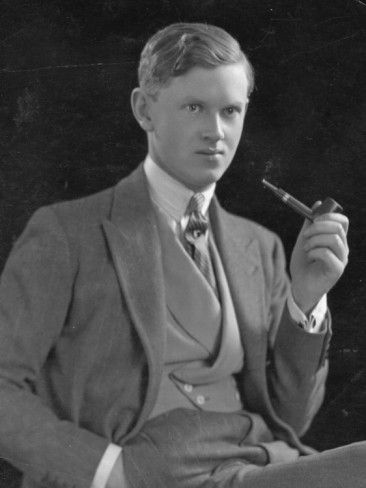
1903 – British poet and novelist Evelyn Waugh was born on this date (d.1996). The English writer is best known for such satirical and darkly humorous novels as Decline and Fall, Vile Bodies, Scoop, A Handful of Dust and The Loved One, as well as for broader and more personal works, such as Brideshead Revisited and the Sword of Honor trilogy, that are influenced by his own experiences and his conservative and Catholic viewpoints. Many of Waugh's novels depict British aristocracy and high society, which he satirizes but to which, paradoxically, he was also strongly attracted. In addition, he wrote short stories, three biographies, and the first volume of an unfinished autobiography. His travel writings and his extensive diaries and correspondence have also been published.
The overt homosexuality of his brother Alec Waugh may have caused Evelyn to hide his own tendencies behind two marriages and seven children. Alec Waugh, like their father, publisher Arthur Waugh, had gone to school at Sherborne, and it was assumed that Evelyn would follow. However, in 1915 Alec was asked to leave, after a homosexual relationship came to light. He departed for military training, and while waiting for his commission to be confirmed wrote a novel of school life, The Loom of Youth, which was published by Chapman and Hall. The novel, which alluded to homosexual friendships in what was recognisably Sherborne, caused a public sensation and offended the school sufficiently to make it impossible for Evelyn to go there. Much to his annoyance he was sent in May 1917 to Lancing, in his view a decidedly inferior establishment. He later went to Oxford.
He arrived in Oxford in January 1922; in October 1922 the arrival of the sophisticated Etonians Harold Acton and Brian Howard changed Waugh's Oxford life. Acton and Howard rapidly became the centre of an avant-garde circle known as the Hypocrites, whose artistic, social and homosexual values Waugh adopted enthusiastically; he later wrote: "It was the stamping ground of half my Oxford life". He began drinking heavily, and embarked on the first of several homosexual relationships, the most lasting of which were with Richard Pares and Alastair Graham.
After gallantly protecting T. S. Eliot from "the specious assumption that he was homosexual," T.S. Matthews in Great Tom, suddenly became viciously ungallant: "It is peppery, glaring little men like Evelyn Waugh who are sexually suspect - as his diaries bear witness."
Indeed, his diaries do clearly reveal him as a Gay man. But then so do his novels, particularly Brideshead Revisited, in which the friendship of Charles and Sebastian, despite the limitations of what he was allowed to write in the early 1940s, is magnificently drawn.


Francis Bacon Self-portrait 1972
1909 – The Anglo-Irish born painter Francis Bacon (d.1992) was a descendant of the Elizabethan philosopher Francis Bacon. His artwork is well known for its bold, austere, and often grotesque or nightmarish imagery. Bacon's painterly but abstract figures typically appear isolated in glass or steel geometrical cages set against flat, nondescript backgrounds. He began painting during his early 20s and worked only sporadically until his mid 30s. Before this time he drifted, earning his living as an interior decorator and designer of furniture and rugs
Bacon early discovered that he attracted a certain type of rich man, an attraction he was quick to take advantage of, having developed a taste for good food and wine. One of the men was an ex-army friend of his father, another breeder of race-horses, named Harcourt-Smith. Bacon later claimed that his father had asked this friend to take him 'in-hand' and 'make a man of him'. Francis had a difficult relationship with his father, once admitting to being sexually attracted to him. Doubtless, Eddy Bacon was aware of his friend's reputation for virility, but not of his penchant for young men. In the early Spring of 1927 Bacon was taken by Harcourt-Smith to the opulent, decadent, "wide open" Berlin of the Weimar Republic, staying together at the Hotel Adlon.
His visit to a 1927 exhibition of 106 drawings by Picasso at the Galerie Paul Rosenberg, Paris, aroused his artistic interest, and he often took the train to Paris five or more times a week to see shows and art exhibitions.
In 1929 he met Eric Hall at the Bath Club, Dover Street, London, where Bacon was working at the telephone exchange. Hall (who was general manager of Peter Jones) was to be both patron and lover to Bacon, in an often torturous relationship.
In 1964, Bacon began a relationship with 39-year-old Eastender George Dyer, whom he met, he claimed, while the latter was burgling his apartment. A petty criminal with a history of juvenile detention and prison, Dyer was a somewhat tortured individual, insecure, alcoholic, appearance obsessed and never really fitting in within the bohemian set surrounding Francis. The relationship was stormy and in 1971, on the eve of Bacon's major retrospective at the Paris Grand Palais, Dyer committed suicide in the hotel room they were sharing, overdosing on barbiturates. The event was recorded in Bacon's 1973 masterpiece Triptych, May-June 1973.
In 1974, Bacon met John Edwards, a young, illiterate, handsome Eastender with whom he formed one of his most enduring friendships, eventually bequeathing his £11m fortune to Edwards after his death.
Bacon died of a sudden heart attack on April 28, 1992, in Madrid, Spain. Bacon bequeathed his entire estate (then valued at eleven million pounds) to John Edwards after his death. Edwards, in turn, donated the contents of Francis Bacon's chaotic studio in South Kensington, to the Hugh Lane gallery in Dublin. Bacon's studio contents were moved and the studio carefully reconstructed in the gallery. Additionally draft materials, perhaps intended for destruction, were according to Canadian Barry Joule bequeathed to Joule who later forwarded most of the materials to create the Barry Joule Archive in Dublin with other parts of the collection given later to the Tate museum.
Bacon's Soho life was portrayed by John Maybury, with Derek Jacobi as Bacon and Daniel Craig as George Dyer (with some lovely frontal nudity on Craig's part) and with Tilda Swinton as Muriel Belcher, in the film Love is the Devil (1998), based on Daniel Farson's 1993 biography The Gilded Gutter Life of Francis Bacon.


1949 – Caitlyn Jenner (born William Bruce Jenner), known as Bruce Jenner until 2015, is an American television personality and former track and field athlete.
A former college football player, Jenner came to international attention as a decathlete, winning the gold medal in the men's decathlon event at the 1976 Summer Olympics in Montreal, and setting a world record not beaten until 1980. With the unofficial title of "world's greatest athlete" for the Olympic decathlon win, he was also an American cult hero winning an event dominated by Soviet Union athletes during the Cold War. He leveraged his celebrity status to endorse products and subsequently starred in numerous movies and television specials including several made-for-TV movies, and was briefly Erik Estrada's replacement on the TV series CHiPs.
Jenner was married for 23 years to Kris Jenner (née Houghton; formerly Kardashian); the couple and their children appeared beginning in 2007 on the television reality series Keeping Up with the Kardashians. Following their divorce in 2015, Jenner came out in a television interview as a trans woman, initially preferring masculine pronouns until his transition was more complete. In June 2015, Jenner revealed her new name, Caitlyn, and a preference for being referred to using feminine pronouns. Many news sources have described her as the most famous openly transgender person in the world.

Bruce Jenner that was.
Jenner is a professed Christian, leans politically conservative, and is a Republican. Prior to her public gender transition, she had been married three times. Her first marriage was to Chrystie Scott (née Crownover) from 1972 to 1981. They have two children, son Burton and daughter Cassandra, known as Burt and Casey. Jenner and Scott's divorce was finalized the first week of January 1981. The same week, on January 5, 1981, Jenner married actress Linda Thompson, in Hawaii. By February 1986, Jenner and Thompson had separated, and they subsequently divorced. They have two sons together, Brandon and Sam Brody, known as Brody. The two sons starred on the reality show The Princes of Malibu and Brody Jenner was also on the reality show The Hills.
Jenner's third marriage, to Kris Kardashian (née Houghton), occurred on April 21, 1991, after five months of dating. They have two daughters, Kendall and Kylie. While married, Jenner was also the step-parent to Kris's four children from her previous marriage to the late lawyer Robert Kardashian: Kourtney, Kim, Khloé and Rob. The couple announced their separation in October 2013, though they had actually separated a year earlier. Kris filed for divorce in September 2014, citing irreconcilable differences. Their divorce terms were finalized in December 2014 and went into effect on March 23, 2015, because of a six-month state legal requirement.
In an April 2015, 20/20 interview with Diane Sawyer, Jenner came out as a trans woman saying she had dealt with gender dysphoria since her youth, and that, for all intents and purposes, "I’m a woman." Jenner cross dressed for many years and did hormone replacement therapy but stopped after the romance with Kris Kardashian in the early 1990s became more serious. Caitlyn recounts having permission to explore her gender identity on her own travels but not when they were coupled, and that not knowing the best way to talk about the many issues contributed to the deterioration of the 22-year-long marriage which formally ended in 2013.


1987 – Frank Ocean (born Christopher Breaux) is an American singer-songwriter and rapper. Ocean started his career as a ghostwriter for artists such as Brandy, Justin Bieber, and John Legend. In 2010, he became a member of alternative hip hop collective OFWGKTA also known as Odd Future, and his debut mixtape, Nostalgia, Ultra, was released to critical acclaim in 2011. The singles "Novacane" and "Swim Good" both achieved chart success.
His debut studio album, Channel Orange, was released in July 2012, promoted with three charting singles: "Thinkin Bout You", "Pyramids", and "Sweet Life".
In 2005, Hurricane Katrina hit Ocean's hometown of New Orleans and his recording facility was destroyed by floodwater and looting. To continue recording music, he moved to Los Angeles and intended to stay for just six weeks but decided to stay longer and develop his music career after establishing contact with people in the music industry. He recorded some demos at a friend's studio and shopped them around Los Angeles.
After getting a songwriting deal, he started working with other record producers and wrote songs for artists such as Justin Bieber, John Legend, Brandy, and Beyoncé. Ocean later said of his work at the time, "There was a point where I was composing for other people, and it might have been comfy to continue to do that and enjoy that income stream and the anonymity. But that's not why I moved away from school and away from family."
Ocean became one of the first major African-American music artists to announce that he had once fallen in love with someone of the same sex, notable because that music scene is known for homophobia.Ocean wrote an open letter, initially intended for the liner notes on Channel Orange, that would preemptively address speculation about his same-sex attraction. Instead, on July 4, 2012, he published an open letter on his Tumblr blog recounting unrequited feelings he had for another young man when he was 19 years old, citing it as his first true love. He used the blog to thank the man for his influence, and also thanked his mother and other friends, saying "I don't know what happens now, and that's alrite. I don't have any secrets I need kept anymore … I feel like a free man."
Members of the hip hop industry generally responded positively to the announcement. Russell Simmons, a business magnate in the hip hop industry, wrote a congratulatory article in Global Grind saying "Your decision to go public about your sexual orientation gives hope and light to so many young people still living in fear." Other artists who expressed their support included Beyoncé and Jay-Z.


1990 – Placido Domingo and Andre Watts raised $1.5 million at a fundraiser for the Gay Men's Health Crisis.


1998 – On this date Welsh secretary Ron Davies resigned from Tony Blair's Labour Party government after British tabloids reported he was robbed at knife-point in a London park while looking for a male sexual companion. Although he subsequently came out as Bisexual, Davies referred to the incident as his "moment of madness."
In 1999 Davies was successfully elected on 6 May 1999 as Member of the Welsh Assembly in the Caerphilly Constituency, and chaired the Economic Development Committee after Alun Michael refused to appoint him to his Cabinet. Shortly before the 2003 assembly elections, "The Sun" revealed that Davies had been visiting a well-known cruising spot near a motorway lay-by (rest stop). When challenged as to what he had been doing there, Davies initially denied being there, then told reporters that he had been going for a short walk, adding: "I have actually been there when I have been watching badgers." Davies was forced to stand down as Labour candidate in the election.


2009 – President Barack Obama signed the The Matthew Shepard Act (officially the "Matthew Shepard and James Byrd, Jr. Hate Crimes Prevention Act") into law. The Act expanded the 1969 United States federal hate-crime law to include crimes motivated by a victim's actual or perceived gender, sexual orientation, gender identity, or disability. It was finally passed after almost two decades of attempts to pass it through Congress and over stiff opposition by members of the Republican party. During debate in the House of Representatives, Republican Representative Virginia Foxx of North Carolina called the "hate crime" labeling of Shepard's murder a "hoax."


5 notes
·
View notes
Text
A Little Crazy
Hard to believe this is all that remains of Gallen Priory, County Offaly, a once-great religious house founded in 492AD by Saint Cadoc. After being badly damaged in the 9th century, the monastery here was restored by Welsh monks but several hundred years later, it came under the authority of the Augustinian order, remaining so until the Dissolution of the Monasteries in the 1540s and thereafter…

View On WordPress
5 notes
·
View notes
Photo
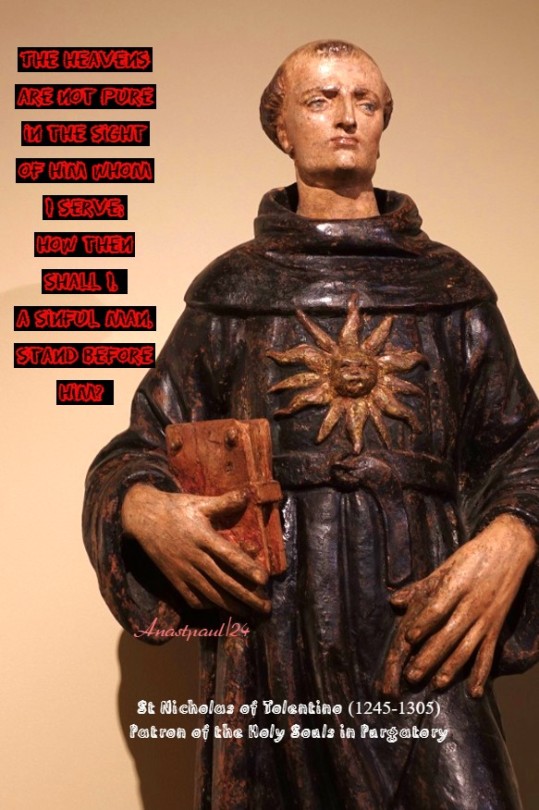

Quote/s of the Day – 10 September – Saint Nicholas of Tolentino OSA (1245-1305) Confessor, “The Patron of Holy Souls” Priest, Augustinian Friar Monk, Mystic, Preacher, Miralce-worker and Apostle of the poor, the sick, the needy. “How can I be said to fast, while every morning, at the Altar, I receive my God?” (Often after his Mass, it was revealed to him that the souls for whom he had offered the Holy Sacrifice, had been admitted to the Presence of God.)
(via Quote/s of the Day – 10 September – Saint Nicholas of Tolentino – AnaStpaul)
3 notes
·
View notes